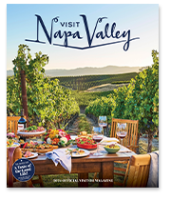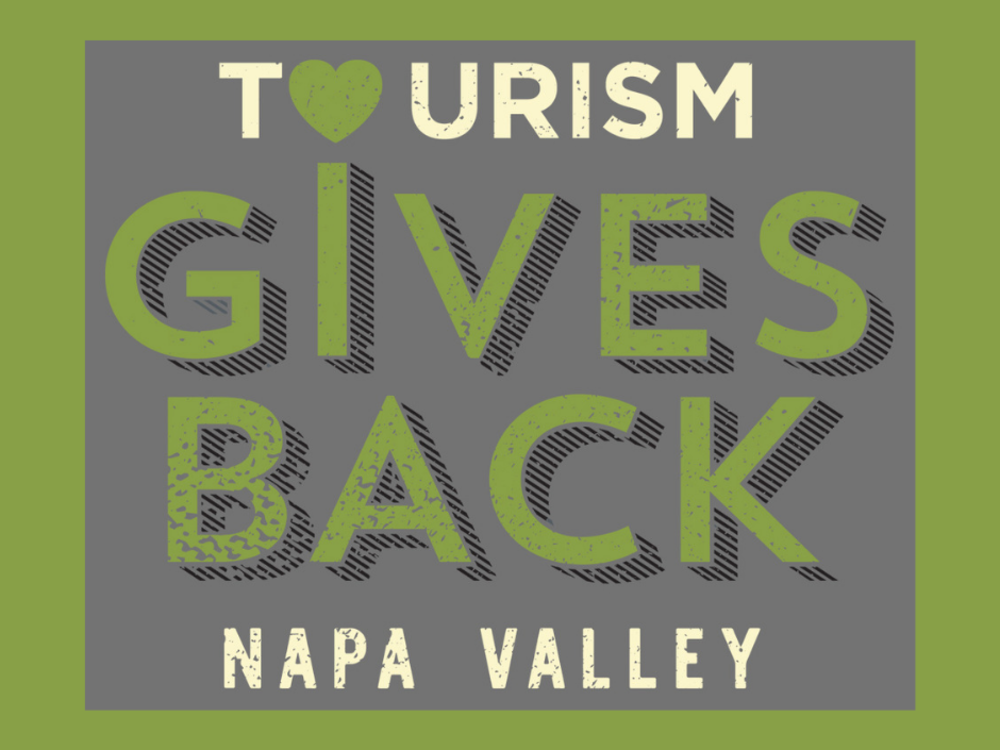In recognition of National Travel and Tourism Week (May 5 - 11, 2019), Visit Napa Valley, the official tourism organization for the Napa Valley, responsible for promoting the community as an attractive travel destination and ideal place to live and work, is pleased to release the “2018 Napa Valley Visitor Industry Economic Impact” and “Visitor Profile” reports, with results of a yearlong research study conducted by Destination Analysts.
In 2018, the Napa Valley welcomed 3.85 million visitors, who spent $2.23 billion and provided $85.1 million in tax relief to residents. This represents an increase of 5.8 percent from 2016 ($80.4 million) for government entities throughout Napa County. Nearly 70 percent of the $2.23 billion is generated from overnight hotel guests, who spent an average of $446 in Napa County per guest, per day. Taxes generated by the visitor industry include revenues from the transient occupancy tax (TOT/hotel tax), sales taxes and property and transfer taxes paid on lodging facilities.
The tourism industry remains the second largest employer in Napa County (after the wine industry), supporting the livelihood of an estimated 15,872 people in the community, with a combined payroll of $492 million.
The Positive Economic Impact of Tourism for Napa Valley
“The tourism industry continues to provide a significant positive impact to Napa Valley’s economy, while also supporting local initiatives essential to the well-being of our community,” states Linsey Gallagher, president and CEO for Visit Napa Valley. “As residents, we sometimes overlook the ancillary benefits that visitor spending achieves. Napa Valley’s healthy and vibrant tourism industry contributes to the quality of life that we are so fortunate to enjoy. We live and work in one of the most desirable destinations in the world.”
Direct visitor spending within Napa County increased 15.9 percent since 2016, outpacing visitor growth of 8.9 percent in the same time period. “Our goal is to maintain and increase travel and spending in the Napa Valley during non‐peak time periods, including November through April (Cabernet Season) and midweek, Sunday through Thursday nights,” adds Gallagher.
Below is a list of transient occupancy tax (TOT/hotel tax) revenue generated in 2018 by each jurisdiction in Napa County:
- American Canyon: $1.5+ million
- City of Napa: $21.6+ million
- Yountville: $6.9+ million
- St. Helena: $3+ million
- Calistoga: $6.2+ million
- Unincorporated Napa County: 13.4+ million
“Revenue from tourism allows local government to invest in services and programs that benefit all residents, including infrastructure improvements, civic amenities, and public safety. Additionally, tourism creates demand for a diverse range of goods, services, and cultural programs that are available for both residents and visitors to enjoy,” adds Gallagher.
In 2018, VNV rallied the support of the hospitality industry and other leaders to pass a voter-supported one percent increase in TOT for a special fund dedicated to workforce housing in five out of six jurisdictions. Approximately $5 million will be collected annually to incent future housing development for residents.
Tourism is the Second Largest Industry in the Napa Valley
In 2018, tourism put an estimated 15,872 people to work in the community providing a combined payroll of $492 million to support their families. This represents an employment increase of 18.1 percent from 2016, (13,437 jobs), and a 27.2 percent increase in combined payroll, ($387 million) in 2016. The majority of hospitality jobs are related to either restaurants (5,697) or hotels (4,097). Since the last survey in 2016, three hotels - Las Alcobas, Vista Collina, and Archer Hotel Napa - opened, along with four smaller inns with 10 rooms or less.
The Economic Impact of Hotel Guests versus “Day Trippers”
More than one-third, or 35.5 percent, of visitors in 2018 stayed overnight in the Napa Valley, while the remaining 64.5 percent were on a day trip to the destination.
In total, 80.7 percent of overnight visitors stayed in a hotel within Napa Valley and 12.4 percent stayed in a private residence.
Compared to the 2016 study, overnight visitation grew 13.7 percent in 2018 (1.2 million) with day trip visitation growing 5.3 percent (2.4 million), supporting Visit Napa Valley’s mission to inspire visitors to extend their stay by experiencing the valley’s more than 125 hotels, motels, and inns.
Hotel guests in 2018 were responsible for $1.55 billion in direct visitor spending, or an average of $446 per person, per day, compared to an average of $170 per person, per day spent by day-trippers. This represents a 15.4 percent increase in spending from 2016 ($1.32 billion).
The largest proportion of day trip visitors originated their trip from San Francisco (70.4 percent), followed by Vallejo-Fairfield (12.2 percent); San Jose (11 percent); Santa Rosa (3.3 percent); and Sacramento (1.4 percent).
Spending
The largest component of visitor spending in 2018 was on retail, which accounted for 40 percent of all spending, or $746 million. The second and third largest components of Napa Valley visitor spending included restaurants at $479 million (21.5 percent) and lodging at $476 million (21.4 percent), respectively. Group meetings, weddings, and social events generated $267 million in direct spending in Napa Valley.
Repeat Visitation
The Napa Valley draws a substantial amount of repeat visitation, with the average visitor in 2018 making 3.6 trips to the Napa Valley in the past twelve months (compared with 2.9 trips in 2016). In total, 88.1 percent of respondents said that they were “very likely” (68.3 percent) or “likely” (19.8 percent) to return to the Napa Valley.
Purpose of Visit
Visitors stated the primary reason for visiting the Napa Valley was for leisure (a getaway or vacation), representing 71.8 percent of all visitors. Wedding or special events represented 11.3 percent of visitors and a conference or business travel represented 5.8 percent of visitors.
Highlights:
- Visitation grew an average of 4.45 percent per year since 2016, with 3.85 million visitors to the Napa Valley in 2018 (3.5 million in 2016).
- The ratio of domestic to international visitors held steady in 2018, with 80.8 percent arriving from within the United States and 19.2 percent international visitors.
- Repeat visitors accounted for 51.4 percent, with 48.6 percent as “first time” visitors.
- The “mean” travel party consisted of 4.4 people who spent an average of $492.93 per trip day in the area, with the bulk of spending attributed to restaurants ($118.08) and wine purchases at wineries ($85.93).
- The “mean” age of the Napa Valley visitor in 2018 was 46, with the largest category (27.3 percent) falling into the 20 – 34 range. Lodging guests were typically older (48.6 years) than day trip visitors (44.7 years).
- Napa Valley visitors are an affluent group with a mean annual household income of $170,595.
- In total, 47.3 percent of visitors surveyed were married and 26.7 percent were single.
- Napa Valley visitors are well educated, with 43 percent having a bachelor’s degree and 29 percent completing graduate school.
Top 10 Domestic States by Volume Percentage:
1. California: 34.4
2. Texas: 6.8
3. New York: 6.1
4. Florida: 5.7
5. Illinois: 4.0
6. Washington: 3.0
7. Ohio: 2.6
8. New Jersey: 2.6
9. Pennsylvania: 2.4
10. Georgia: 2.2
Top 10 International Countries by Volume Percentage:
1. Canada: 17.7
2. China: 17.0
3. United Kingdom: 14.3
4. Japan: 7.8
5. Australia: 6.0
6. South Korea: 4.3
7. Mexico: 4.0
8. Holland: 3.3
9. Germany: 2.8
10. Singapore: 2.1
Napa Valley Areas Visited:
Visitors to the Napa Valley tend to visit multiple towns within the area. By percentage, the City of Napa received the highest number of visitors in 2018.
- City of Napa: 71.0
- St. Helena: 56.6
- Oakville: 33.8
- Calistoga: 31.9
- Yountville: 31.2
- Rutherford: 19.5
- Carneros area: 7.2
- Lake Berryessa area: 4.6
- American Canyon: 4.0
- Angwin: 1.8
Napa Valley Attractions and Experiences:
Visitors were presented with a list of twenty-one activities and asked which they participated in while in the Napa Valley. Wine tasting at wineries remains the most popular visitor experience, followed by dining in restaurants. Napa Valley experiences were ranked by percentage.
- Wine tasting at wineries: 81.0
- Dining in restaurants: 65.2
- Winery tours: 45.3
- Shopping: 39.8
- Napa Valley Wine Train: 27.6
- Wine tasting rooms (stand-alone): 20.1
- Spa visit or treatment: 8.7
- Farmer’s markets: 8.3
- Bars or nightlife: 7.7
- State or local parks: 7.1
- Art galleries/art walks, etc.: 6.5
- Hiking: 5.8
- Other culinary activities: 5.2
- Guided tours: 4.7
- Festivals or special events: 3.8
- Hot air ballooning: 2.8
- Biking: 2.3
- Performing Arts (theater, live music, etc.): 1.4
- Golf: 1.3
- Canoeing/kayaking: .6
Wineries and/or Tasting Rooms
In 2018, the Napa Valley visitor experienced 3.7 wineries during their visit (representing an increase from 3.1 wineries in 2016), and 1.4 stand-alone tasting rooms. Nearly all visitors surveyed went to at least one winery while in Napa Valley (97.2 percent) and 73.8 percent went to at least one tasting room. While 38.8 percent of visitors surveyed in 2018 made advanced winery appointments, lodging guests were significantly more likely to make appointments (50.2 percent) than the day trip visitor (32.8 percent).
Airports
In 2018, San Francisco Airport (SFO) was the most commonly used airport by Napa Valley visitors, representing more than 70 percent of all visitors. Oakland International Airport received 10 percent of visitors, followed by Sacramento International Airport, with 6.6 percent.
Visitor Profile Research Methodology
The research surveys for the 2018 Napa Valley Visitor Profile consists of three parts: a Napa Valley lodging guest survey; a Napa Valley visitor intercept survey of day-trip visitors and those staying with friends or relatives in private homes; and an online panel and telephone survey of Napa County homeowners to quantify visitors staying in private homes.
The overarching goal of this survey-based research was to create an in-depth profile of the Napa Valley visitor, including collecting market intelligence on detailed trip characteristics (the reason for visiting Napa Valley, length and place of stay, etc.); activities and attractions visited; visitor spending estimates; travel planning resources; visitor expectations and satisfaction; and visitor psychographic and demographic profiling.
Find the full “2018 Napa Valley Visitor Industry Economic Impact” report and “2018 Visitor Profile” reports here.
###
About Visit Napa Valley
Visit Napa Valley is the official tourism marketing organization for the Napa Valley, with a mission to promote, protect and enhance the region’s position as one of the world’s premier wine, food, arts and wellness destinations.
The Napa Valley, conveniently located just an hour from the San Francisco Bay Area, consists of the following distinctive towns, including, from north to south, Calistoga, St. Helena, Rutherford/Oakville, Yountville, the city of Napa, American Canyon, and the outdoor recreation area of Lake Berryessa.
The Napa Valley Welcome Center, located at 600 Main St. along the riverfront in downtown Napa, provides visitors with expert Concierge services from Napa Valley Ambassadors who offer complimentary Napa Valley magazines, maps, brochures and winery tasting passes. The Welcome Center, open daily 9 a.m. – 5 p.m., also offers complimentary Wi-Fi and a mercantile shop featuring locally sourced gift items.
For additional information on the Napa Valley, or to plan your Napa Valley experience, please explore VisitNapaValley.com and follow us on Facebook and Instagram @VisitNapaValley.
Media Contact:
Angela Jackson, Director of Media Relations
Visit Napa Valley
Angela@visitnapavalley.com
707-260-0114







